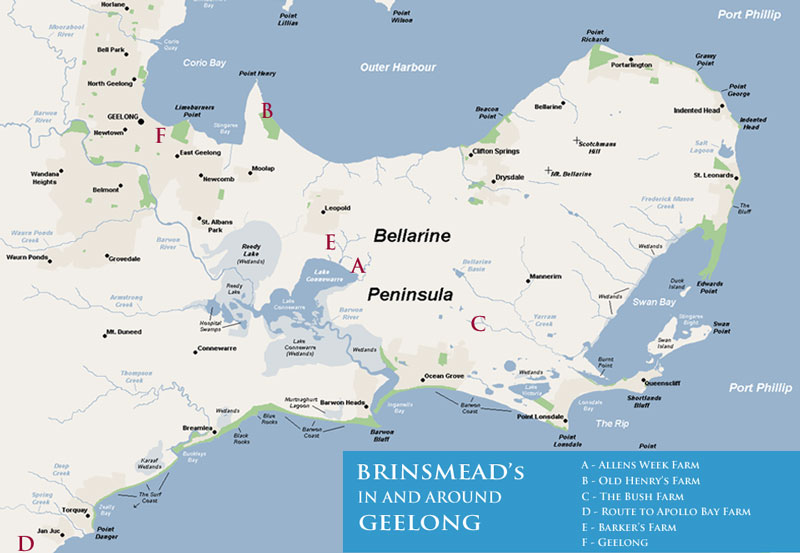The Brinsmeads of Geelong - A preliminary guide
The largest contingent of Brinsmeads to leave St. Giles in the Wood for Australia settled initially in the area near Geelong and the Bellarine Peninsula. They were all related - brothers, sisters and cousins, but came on different voyages. The Brinsmeads from Geelong have since spread across Australia, the youngest now the seventh generation of natural born Australians. However, there are still Brinsmeads living in Geelong to this day.

The Original Settlers
The first generation of settlers in the Geelong area involved two couples, Henry and Betsy Brinsmead who settled on land near Port Henry (B on the Map above) and William and Ann Brinsmead who settled on the shores of Lake Connewarra (A on the map above.) They had a second farm - "The Bush Farm" a few miles away on the road to Queenscliff (C on the map). Each came with a young family. They were joined by Elizabeth Brinsmead.
William and Henry were brothers. Betsy and Ann were sisters. Thus, each of Henry and William married their cousins. However, Betsy had been married earlier to John Hackwill, who died six years after they were married, leaving Betsy with two young children. Elizabeth was a younger sister to Betsy and Ann.
One other couple needs mention and that is the Barker family; Henry Barker and Margaret Lynch. They were very early settlers in the area, fellow Methodists, and close neighbours to William and Ann Brinsmead (roughly E on the map). Of particular importance is that two of their daughters married William and Ann's twin sons, Henry and Reuben Brinsmead.
The Second Generation - Henry and Betsy Brinsmead of Port Henry
Henry and Betsy arrived in Australia with an already blended family. There were Betsy's two sons by John Hackwill; John Hackwill and Thomas Brinsmead Hackwill. John had already married in England. Then there were Henry and Betsy's children; four daughters; Elizabeth, Mary, Harriet and Ruth (a baby who died in the first year in Australia) and a son William. All the surviving children married, creating the following second generation families:
John Edward Hackwill and Fanny Vodden- lived in Geelong West, originally know as Ashby
Thomas Brinsmead Hackwill and Margaret Bell Carlisle - Lived on the farm at Port Henry
Elizabeth Brinsmead and John Daniel - Lived in Geelong
Mary Brinsmead and William Capron- Lived in Geelong and then Lethbridge, about 10 miles North of Geelong
William Brinsmead and Carolyn Radford - Lived in Geelong
Harriet Brinsmead and Richard Trounce - Lived in Ballarat
The Second Generation - William and Ann Brinsmead of (Kensington) Leopold
William and Ann arrived with children Mary Ann and William. Their eldest son Thomas Ireland may have arrived separately and appear to have gone straight to the goldfields. Elizabeth was born in Australia soon after they arrived. They then had twin boys, Henry and Reuben. Two more children followed but died in infancy. Mary Ann married John Wood. William died in 1862 at age 15. Elizabeth also died young. Henry and Reuben each married one of the Barker daughters. When the farm became too big for both sons, Reuben and family left for Morwell. Henry continued to work Allens Week Farm as well as the Bush Farm and yet another farm 80 miles away down the Great Ocean Road (D on the map indicates the general direction)
The second generation in this line involved the following couples:
Thomas Ireland Brinsmead and Elizabeth Jackson - First lived in Ballarat and then moved to the Newcastle area.
Mary Ann Brinsmead and John Wood - Lived in Geelong.
Henry Brinsmead and Jemima Barker - Lived in Geelong - left the Methodists for the Seventh Day Adventists.
Reuben Brinsmead and Louisa Barker - Lived in Geelong until 1895 then moved to Morwell
The Next Generations
Gradually, we hope to expand the Australian pages to include descriptions of each of these branches of the family, but these two generations each resulted in many more branches resulting in by far the largest contingent of Brinsmeads in Australia. More links will be added to this preliminary guide page as this work progresses.
